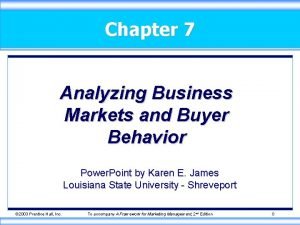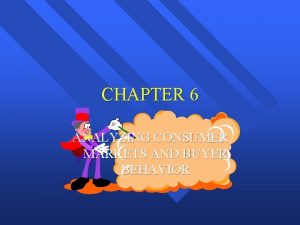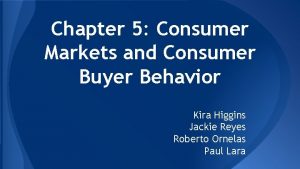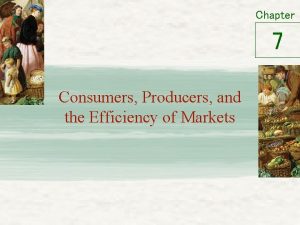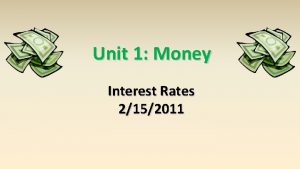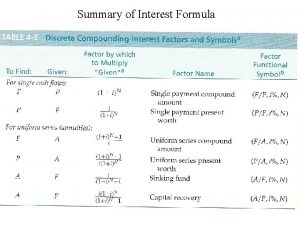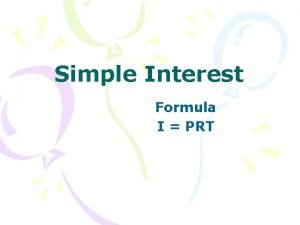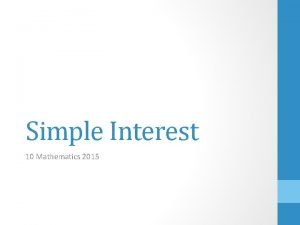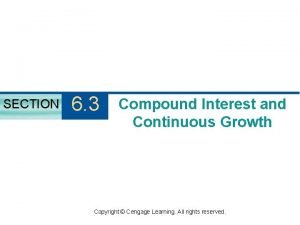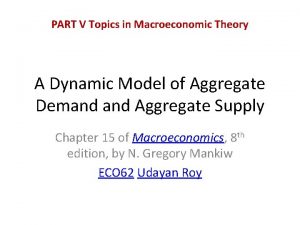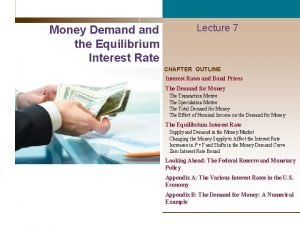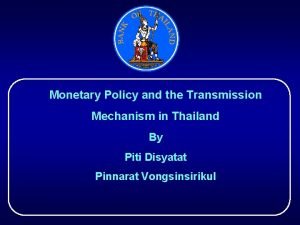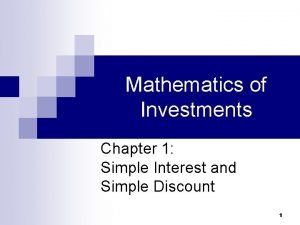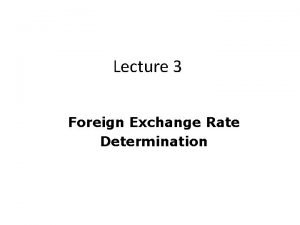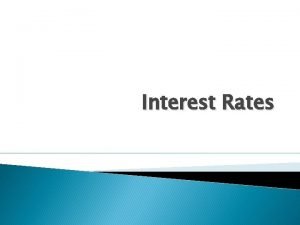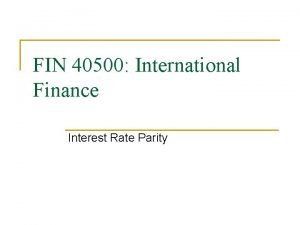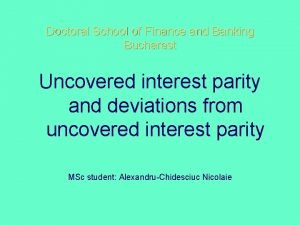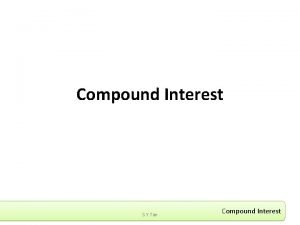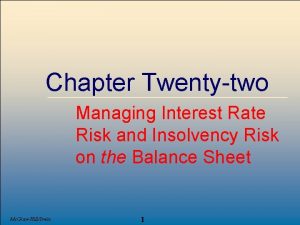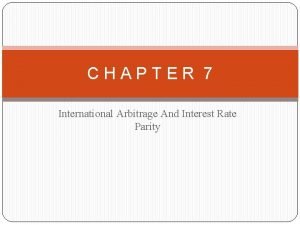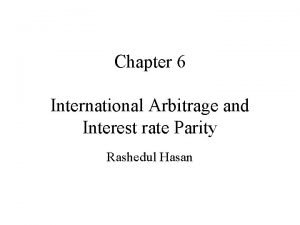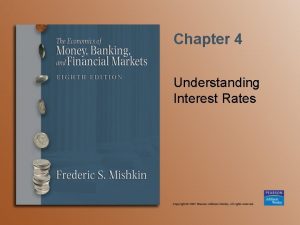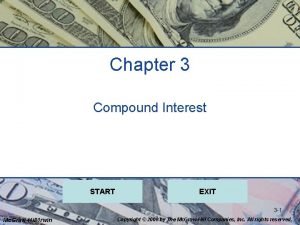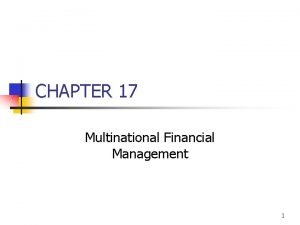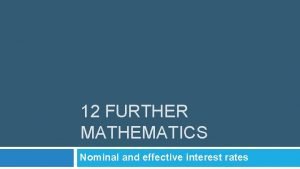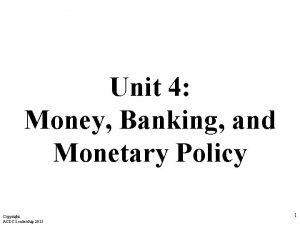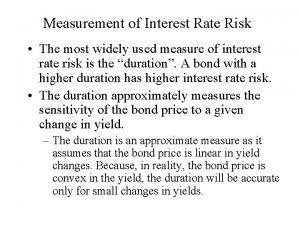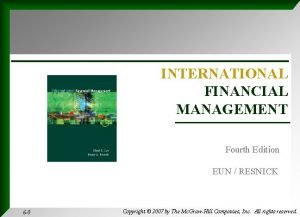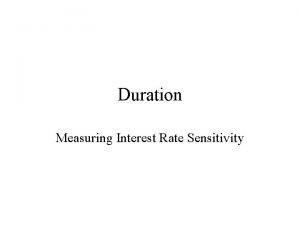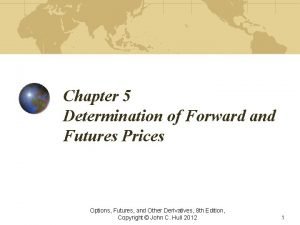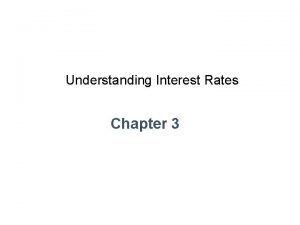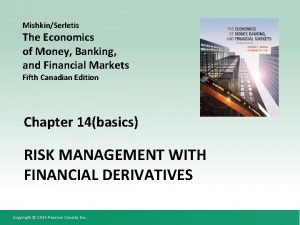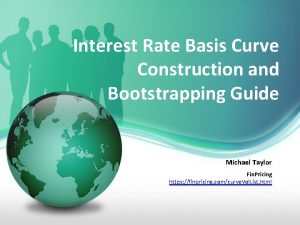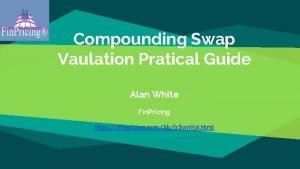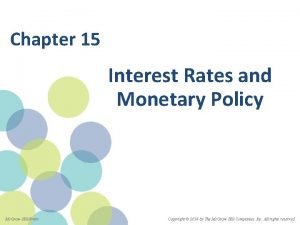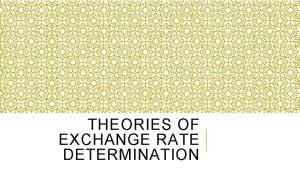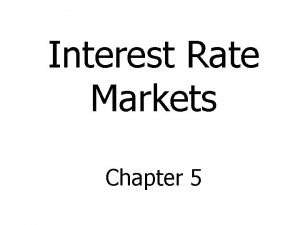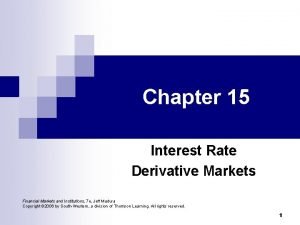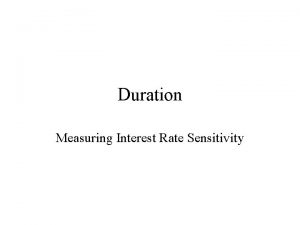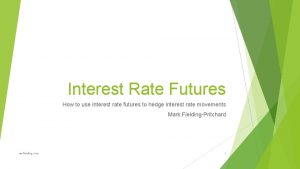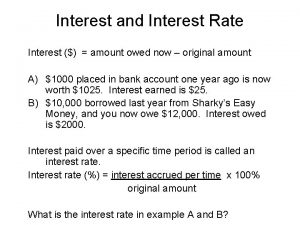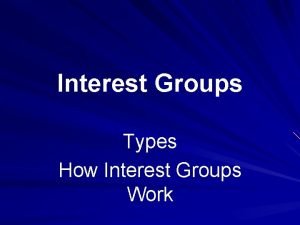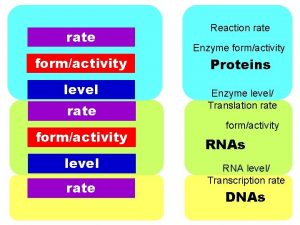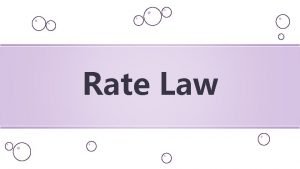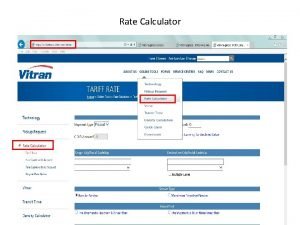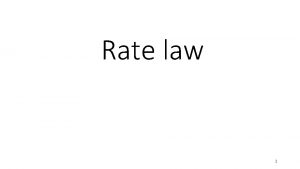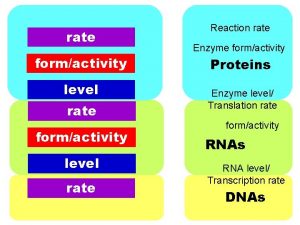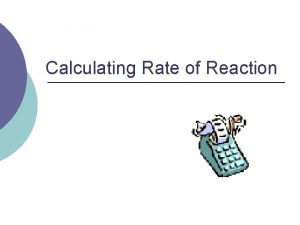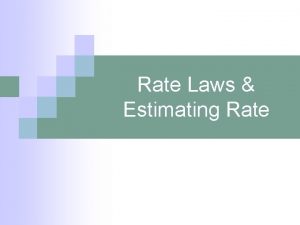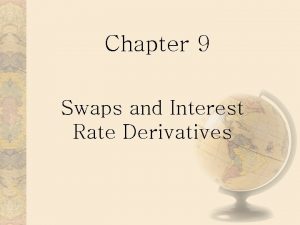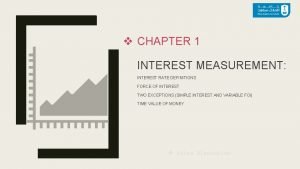Interest Rate Markets Chapter 4 Types of Interest



































































- Slides: 67

Interest Rate Markets Chapter 4

Types of Interest Rates • Repurchase rates • Treasury rates • LIBOR

The market for Repurchase Agreements An integral part of trading T-bills and T-bill futures is the market for repurchase agreements or repos. Repos are used in much of the arbitrage trading in T-bills. In a repurchase agreement a borrower sells a security (in this case, T-bills) to another party for one price and commits to repurchase the security for another price at a future date. The buyer of the T-bills in a repo is said to enter into a reverse repurchase agreement. , or reverse repo. The buyer’s transactions are just the opposite of the seller’s. The figure below demonstrates the transactions in a repo. 3

Transactions in a Repurchase Agreement Date 0 - Open the Repo: Party A T- Bill PO Party B Date t - Close the Repo T-Bill Party A Party B Pt= P 0(1+r 0, t ) 4

Example: T-bill FV = $1 M. P 0 = $980, 000. The repo rate = 6%/annum The repo is for: n = 4 days. P 1= P 0 [1 + (repo rate)(n/360)] = $980, 000[1 + (. 06)(4/360)] = $980, 653. 33 5

A repurchase agreement effectively allows the seller to borrow from the buyer using the security as collateral. The seller receives funds today that must be paid back in the future and relinquishes the security for the duration of the agreement. The interest on the borrowing is the difference between the initial sale price and the subsequent price for repurchasing the security. The borrowing rate in a repurchase agreement is called the repo rate. 6

The buyer of a reverse repurchase agreement receives a lending rate called the reverse repo rate. The repo market is a competitive dealer market with quotations available for both borrowing and lending. As with all borrowing and lending rates, there is a spread between repo and reverse repo rates. 7

The amount one can borrow with a repo is less than the market value of the security by a margin called a haircut. The size of the haircut depends on the maturity and liquidity of the security. For repos on T-bills, the haircut is very small, often only one-eighth of a point. It can be as high as 5% for repurchase agreements on longer-term securities such as Treasury bonds and other government agencies 8

Most repos are held only overnight, so those who wish to borrow for longer periods must roll over their positions every day. However, there are some longer-term repurchase agreements, called term repos, that come in standardized maturities of one, two, and three weeks and one, two, three, and six months. Some other customized agreements also are traded. 9

Zero Rates A zero rate, r, (spot rate), for maturity T is the rate of interest earned on an investment that provides a payoff only at time T. T need not be integer. US T-bills yield zero rates. US Gov long-term zero rate bonds are called: STRIPS 10

Treasury Bill Quotes in the U. S. If B is the cash price of a Treasury bill that has n days to maturity the quoted price is

Quotes: The discount yield

The Bond Equivalent yield (BEY)

Example: n = 90 days. FV = $1, 000. d = 11%.

The Discount yield and The Bond Equivalent Yield

Forward Rates Forward rates are the zero rates implied by today’s term structure of interest rates. R 1, 2 R 1 0 T 1 T 2

In the absence of arbitrage:

Calculation of Forward Rates Table 4. 5, page 85 Zero Rate for an n -year Investment Year (n ) (% per annum) 1 3. 0 2 4. 0 3 4. 6 4 5. 0 5 5. 3

Year Zero rates 1 - year forward 2 – year forward 3 – year forward 4 – year forward 1 3. 0% 2 4. 0% 3 4 5 4. 6% 5. 0% 5. 3% 5. 0% 5. 8% 6. 2% 6. 5% R 3, 4 R 4, 5 R 1, 2 R 2, 3 5. 4% 6. 0% 6. 35% R 3, 5 R 1, 3 R 2, 4 5. 67% 6. 17% R 1, 4 R 2, 5 5. 875% R 1, 5 19

Upward vs Downward Sloping Yield Curve • For an upward sloping yield curve: Fwd Rate > Zero Rate > Par Yield • For a downward sloping yield curve Par Yield > Zero Rate > Fwd Rate

Forward Rate Agreements (Sec 4. 7) • A forward rate agreement (FRA) is an agreement that a certain rate will apply to a certain principal during a certain future time period

Theories of the Term Structure (P. 93) Expectations Theory: forward rates equal expected future zero rates Market Segmentation: short, medium and long rates are determined independently of each other • Liquidity Preference Theory: forward rates are higher than expected future zero rates by a liquidity premium

Treasury Bond Price Quotes in the U. S Cash price = Quoted price + Accrued Interest The accrued interest is the interest accumulated (but not paid out) from the last coupon payment through the current day. Last Coupon B Next Coupon

A BOND is a promisory note to pay a certain cash flow in the future. Bond parameters: B = The bond quoted price. FV = The Face value (Par value) of the bond. M = Maturity date of the bond. t = The time index. t = 1, 2, …, M. Ct = The cash paid to the bond holder by the end of period t. CR = The bond’s coupon rate.

Bond parameters: Usually, the cash flow from the bond is a series of equal amounts – the coupons. Ct = C t = 1, 2, …, M. The coupon payment is based on the FV and on the Coupon Rate CR: C = [CR][FV] FV = $1, 000 CR = 7% C = $70, if paid annually; $35, if paid semiannually.

Theoretical Bond Pricing: An example: FV = $100; M = 2 years; CR = 6% C/2 = $3, paid semiannually. p. 81. TIME CF . 5 yr $3 0 -RATE 5. 0% 1 yr $3 1. 5 yr $3 2 yr $103 5. 8% 6. 4% 6. 8% 26

Theoretical Bond Pricing: Example • To calculate the cash price of a bond, B, we discount each cash flow at the appropriate zero rate

The Bond Yield to Maturity (YTM) • The bond YTM, y, is the discount rate that equals the bond’s market price to the present value of the cash flows from the bond. • Example: Assume that B = 98. 39 • YTM is given by solving: to obtain: y=0. 0676 or y = 6. 76%.

Bond Yield To Maturity (YTM) In the actual bond markets, the calculations are different from theoretical bond pricing above. Mostly, the discounting is NOT continuous. Rather it is periodical and the YTM, y, is used in the calculation of the bond’s market price.

30

31

Moreover, most bonds pay the same coupon annually. Thus, Ct = C for all periods. The above formula becomes: 32

YTM, another interpretation: 33

Many bonds pay the same coupon semiannually: or Ct = C/2 for all periods. The above formula becomes: 34

Example 1: A 25 -year T-bond with Face Value of $1, 000 pays annual coupons at an 8% rate. M = 25; FV = $1, 000; CR = 8%; c = $80. An investor who buys this T-bond will receive $80 every year from now until its maturity; plus $1, 000 by the end of the 25 th year of the bond’s life.

The same bond with YTM = 8% is priced: 36

Example 2: A 25 -year T-bond with Face Value of $1, 000 pays coupons at an 8% rate semiannually. M = 25; FV = $1, 000; CR = 8%; m = 2; N = Mm = 50 and c = $40. An investor who buys this T-bond will receive $40 every six months from now until its maturity; plus $1, 000 by the end of the 25 th year of the bond’s life.

Ct = C/2 = $40 for 50 periods. If YTM = 8% the above bond is priced: 38

Example 2 revisited. Ct = C/2 = $40 for 50 periods. With YTM = 10% 39

Example 2 revisited. Ct = C/2 = $40 for 50 periods. With YTM = 5% 40

Result: When CR = y B = FV. The bond sells at par. When CR > y B > FV. The bond sells at a premium. When CR < y B < FV. The bond sells at a discount. 41

A pure discount bond: Example 1 revisited: A consul: pays $80 annually, FOR EVER. 42

DURATION IS THE WIEGHTED AVERAGE MATURITY OF A BOND. THE WEIGHTS ARE THE PROPORTIONS THAT THE DISCOUNTED CASH FLOWS ARE OF THE CURRENT BOND PRICE. 43

DURATION Duration is a measure of the bond’s price volatility. The concept of Duration can be used for all assets, liabilities and off-balance sheet items. Duration applies for a single asset, a portfolio or the entire balance sheet. In computing Duration we consider both the timing and the magnitude of all cash flows associated with the security. 44

45

Duration in continuous time(p. 89) • Duration of a bond that provides cash flow c i at time t i is where B is its price and y is its yield (continuously compounded) • In the continuous discounting case:

DURATION INTERPRETED AS A MEASURE OF THE BOND PRICE SENSITIVITY 47

The negative sign merely indicates that D changes in opposite direction to the change in the yield, y. 48

DURATION as the bond’s price Elasticity Suppose that D = -7. 51. The above interpretation means: If the Bond’s YTM, y, rises (falls) by 1% The Bond’s price will decrease (increase) by 7. 51% 49

DURATION: A CLOSED FORMULA: N = The total number of payments. m = The number of payments every year. Φ = The fraction of the year to the next coupon payment. 50

Example 1 M = 30; m = 1; N = 30; Φ = 1; y = 10%; FV = $100; CR = 6% c = $6 51

Coupon Rate 52

Example 2 M = 15; m = 1; N = 15; Φ = 1; y = 10%; FV = $100; CR = 14% c = $14 53

The bond’s price CHANGE 54

Modified Duration(p 91) • When the yield y is expressed with compounding m times per year • The expression is referred to as the modified duration

DURATION OF A BOND PORTFOLIO Di = Bond’s I Duration; i = 1, …, n. Bi = The value of the i-th bond Ni = The number of bonds’ i in the portfolio V i = Bi N i = The total value of the i-th bond in the portfolio VP = ΣBi. Ni The total bond portfolio value. Theorem: DP = Σwi. Di. wi = Vi/VP 56

57

58

59

60

61

IN WORDS: The portfolio Duration is: the weighted average of the durations of the bonds in the portfolio. The weights are the proportions each of the bonds values are of the entire portfolio value. 62

Example: a portfolio of two T-bonds: BOND N YTM COUPON T-BOND FV in $M $100 15 yrs 6% 5% T-BOND $200 30 yrs 6% 15% BOND PRICE W D T-BOND $90. 2 0. 1673 10. 4673 T-BOND $449. 1 0. 8327 12. 4674 539. 3 1. 0000 D = (. 1673)(10. 4673) +(. 8327)(12. 4674) = 12. 1392 63

Example: a two bond portfolio: BOND FV YTM CUPON T-BOND 1 $500 M 15 yrs 6% 5% T-BOND 2 $200 M 30 yrs 6% 15% BOND T-BOND 1 T-BOND D N 2 PRICE $451, 5 M $449, 1 M $900, 6 M W 0, 5013 0, 4987 1, 0000 D 10, 4673 12, 4674 = (0, 5013)(10, 4673) +(0, 4987)(12, 4674) = 11, 45. 64

APPLICATION OF DURATION IMMUNIZING BANK PORTFOLIO OF ASSETS AND LIABILITIES TIME 0 ASSETS $100, 000 (LOANS) D=5 y = 10% TIME 1 y => 12% LIABIABILITIES $100, 000 (DEPOSITS) D=1 y = 10% 65

BUT IF DA = DL The Asset value and the Liabilities value REACT TO RATES CHANGES IN EQUAL AMOUNTS. THE BANK PORTFOLIO IS IMMUNIZED , i. e. , IT’S VALUE WILL NOT CHANGE FOR A “small” INTEREST RATE CHANGE, IF THE PORTFOLIO’S DURATION IS ZERO or: DP = DA - DL = 0. 66

APPLICATIONS OF DURATION. EXAMPLE: A 5 -YEAR PLANNING PERIOD CASE OF IMMUNIZATION IN BOND C FV M A $100 $1, 000 5 yrs B $100 $1, 000 10 yrs THE CASH MARKET y D P 10% 4. 17 $1, 000 10% 6. 76 $1, 000 4. 17 WA + 6. 76 WB = 5 W A+ WB = 1 WA =. 67953668. WB =. 32046332. VP = $200 M implies: Hold $135, 907, 336 in bond A, And $64, 092, 664 in bond B. 67
 Nominal v. real interest rates
Nominal v. real interest rates Cap rate interest rate relationship
Cap rate interest rate relationship Nominal vs effective interest rate
Nominal vs effective interest rate 4 types of markets
4 types of markets Types of markets grade 8
Types of markets grade 8 4 types of markets
4 types of markets Chapter 9 section 2 types of interest groups
Chapter 9 section 2 types of interest groups Simple and compound interest
Simple and compound interest Financial markets and institutions chapter 1
Financial markets and institutions chapter 1 Cultural dynamics in assessing global markets
Cultural dynamics in assessing global markets Consumer markets and consumer buyer behavior
Consumer markets and consumer buyer behavior Chapter 9 expanding markets and moving west
Chapter 9 expanding markets and moving west Analyzing consumer and business markets
Analyzing consumer and business markets Buyer influences in business markets
Buyer influences in business markets Chapter 18 the markets for the factors of production
Chapter 18 the markets for the factors of production Chapter 5 consumer markets and buyer behavior
Chapter 5 consumer markets and buyer behavior Analyzing consumer markets
Analyzing consumer markets Chapter 5 consumer markets and buyer behavior
Chapter 5 consumer markets and buyer behavior Firms in competitive markets chapter 14 ppt
Firms in competitive markets chapter 14 ppt Chapter 9 expanding markets and moving west
Chapter 9 expanding markets and moving west Chapter 9 expanding markets and moving west
Chapter 9 expanding markets and moving west Chapter 7 consumers producers and the efficiency of markets
Chapter 7 consumers producers and the efficiency of markets Interest rate effect
Interest rate effect Discrete compound interest formula
Discrete compound interest formula Simple interest formula
Simple interest formula What is the simple interest formula
What is the simple interest formula Compounded continuously formula
Compounded continuously formula Nominal versus real returns
Nominal versus real returns Dad das model
Dad das model Effective interest formula
Effective interest formula Money demand and interest rate
Money demand and interest rate Interest rate transmission mechanism
Interest rate transmission mechanism Contractionary monetary policy
Contractionary monetary policy How to find principal amount
How to find principal amount Interest rate parity theory
Interest rate parity theory Interest rates quotes
Interest rates quotes Cheapest to deliver bond
Cheapest to deliver bond Interest rate parity example
Interest rate parity example Uncovered interest rate parity formula
Uncovered interest rate parity formula Maturity value formula
Maturity value formula Interest rate parity example
Interest rate parity example Interest rate duration
Interest rate duration Covered interest arbitrage
Covered interest arbitrage Interest rate futures
Interest rate futures International arbitrage and interest rate parity
International arbitrage and interest rate parity Mora interest rate
Mora interest rate Interest rate compounded annually
Interest rate compounded annually Interest rate implicit in the lease formula
Interest rate implicit in the lease formula Multinational financial management requires that
Multinational financial management requires that What is expansionary monetary policy
What is expansionary monetary policy Effective monthly interest rate
Effective monthly interest rate Decreasing money supply
Decreasing money supply Is interest rate discrete or continuous
Is interest rate discrete or continuous Agdao multi purpose cooperative branches
Agdao multi purpose cooperative branches Measuring interest rate risk
Measuring interest rate risk Interest rate parity
Interest rate parity Interest rate risk sensitivity analysis
Interest rate risk sensitivity analysis Forward interest rate formula
Forward interest rate formula Forward interest rate formula
Forward interest rate formula Zero coupon bond formula
Zero coupon bond formula Advantages of interest rate swaps
Advantages of interest rate swaps Irr interest rate
Irr interest rate Interest rate collars
Interest rate collars Interest rate curve construction
Interest rate curve construction Hedging interest rate risk with futures
Hedging interest rate risk with futures Compounding swap
Compounding swap Type of interest rate
Type of interest rate Exchange rate theories
Exchange rate theories












